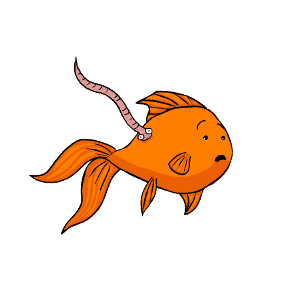Lice and worms are common goldfish tank parasites, both of which can potentially lead to health problems in your fish and so, should be dealt with as soon as a potential issue arises.
What are goldfish lice and worms?
Fish tank lice and worms are parasites that rely upon goldfish to thrive and reproduce, and will often be most prevalent in overcrowded tanks and on fish that have recently been bought from a pet store.
It is of course important to ensure that you do not let your tank become overcrowded, and that you quarantine any new fish for 14 days to a month before you introduce them to your main tank.
Tapeworms, anchor worms and body lice are three of the most common parasitic problems that can affect goldfish, and these three invaders are sometimes found together.
Symptoms of lice or worms in goldfish
Lice and worms are of course different creatures, but both can lead to visible ailments in your fish, as well as a general listlessness and ill health. Be alert for any of the following signs and symptoms of these parasites within your tank:
- Moving, disc-shaped parasites on your fish that can be as large as 5mm are indicative of adult fish lice
- Fish appearing itchy, irritated and stressed, even breaking the surface of the water in an attempt to gain some relief from the irritation also commonly indicates lice infestation, even if you cannot see actual lice
- Visible body wounds on your fish, which may also grow fungus
- Anchor worms are related to fish lice, and again, will often be visible on your fish, hanging from the head, flanks or fins
- Red sores and lumps that look like boils may also appear on the body of your fish
- Tapeworms are an internal parasite, which will usually be apparent in your fish due to a fast loss of weight and condition
- You may also see live or dead tapeworms in your fish’s stools, or hanging from the anus of the fish
- All of these parasites are highly debilitating to your fish, and your fish will usually appear to be in poor condition and not very happy when suffering from an infestation
What causes lice and worms within the goldfish tank?
Introducing new fish or the water that held new fish into the tank is the easiest way to bring parasites into your tank, and so quarantining new fish before introduction is vitally important.
If you spot signs of parasites or suspect that one of your goldfish is unwell, isolate them immediately in order to do what you can to limit the spread of the condition to other fish.
Even if you have quickly removed an affected fish from the tank, it is vital to keep a close eye on the remaining fish in order to spot the signs of any parasites that may remain.
How can lice and worms be treated?
There are many different broad-spectrum anti-parasitic medications that you can add to the goldfish tank in order to eradicate parasites such as worms and lice, and these are usually highly effective, although they may require more than one treatment.
In the case of anchor worms, you may need to physically remove visible worms from the body of your fish using a pair of tweezers in order to give them the best chance of recovery.
If your tank has played host to either lice or worms, it is important to treat the main tank itself, even if the remaining fish after you have removed any sick ones are not showing any signs of illness.
